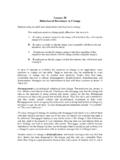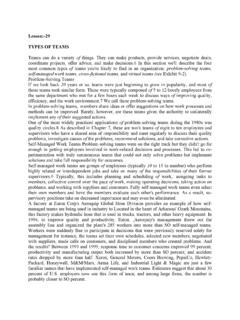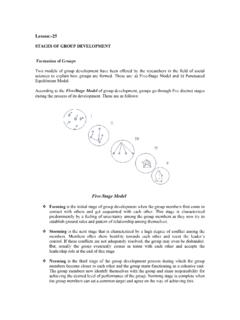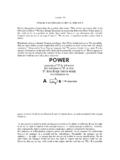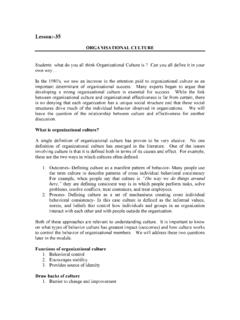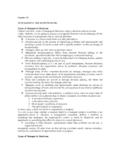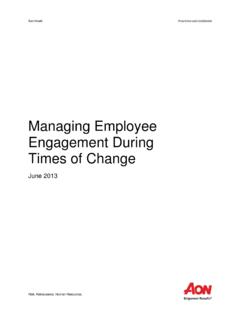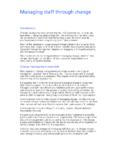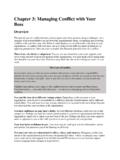Transcription of Lesson:-37 ORGANIZATIONAL CHANGE
1 lesson :- 37 organizational change Dear students, today we shall learn about CHANGE and its impact of CHANGE on organizations. Perhaps the only thing constant within organisations is now CHANGE . Traditionally, analysis of organisational CHANGE has been built around the organism metaphor in which organisations are analyzed as if they were living organisms operating in an environment to which they need to adapt to ensure survival. For an organisation, its environment may be broken down into: * Societal factors * Environment factors and * Internal factors.
2 This is an era of globalization and the organizations need to cope up with the dynamic and inevitable changes which take place very often. Because of this changes the competition among firms is becoming intense and every organization should be flexible enough to implement the changes whenever required for its survival. There are two basic forms of CHANGE in organizations. Planned CHANGE is CHANGE resulting from a deliberate decision to alter the organization. Companies that wish to move from a traditional hierarchical structure to one that facilitates self-managed teams must use a proactive, carefully orchestrated approach.
3 Not all CHANGE is planned, however. Unplanned CHANGE is imposed on the organization and is often unforeseen. Changes in government regulations and changes in the economy, for example, are often unplanned. Responsiveness to unplanned CHANGE requires tremendous flexibility and adaptability on the part of the organizations. Managers must be prepared to handle both planned and unplanned forms of CHANGE in organizations. Forces for CHANGE Forces for CHANGE can come from many sources. Some of these are external, arising from outside the company, whereas others are internal, arising from sources within the organization.
4 External Forces The four major external forces for CHANGE are globalization, workforce diversity, technological CHANGE , and managing ethical behavior are challenges that precipitate CHANGE in organizations. Internal Forces Pressures for CHANGE that originate inside the organization are generally recognizable in the form of signals indicating that something needs to be altered. Declining effectiveness is a pressure to CHANGE . A company that experiences its third quarterly loss within a fiscal year is undoubtedly motivated to do something about it.
5 Some companies react by instituting layoffs and massive cost cutting programs, whereas others look at the bigger picture, view the loss as symptomatic of an underlying problem, and seek the cause of the problem. A crisis also may stimulate CHANGE in an organization. Strikes or walkouts may lead management to CHANGE the wage structure. The resignation of a key decision-maker is one crisis that causes the company to rethink the composition of its management team and its role in the organization. A much-publicized crisis that led to CHANGE with Exxon was the oil spill accident with Exxon s Valdez oil tanker.
6 The accident brought about many changes in Exxon s environmental policies. Changes in employee expectations also can trigger CHANGE in organizations. A company that hires a group of young newcomers may be met with a set of expectations very different from those expressed by older workers. The work force is more educated than ever before. Although this has its advantages, workers with more education demand more of employers. Today s workforce is also concerned with career and family balance issues, such as dependent care. The many sources of workforce diversity hold potential for a host of differing expectations among employees Changes in the work climate at an organization can also stimulate CHANGE .
7 A workforce that seems lethargic, unmotivated, and dissatisfied is a symptom that must be addressed. This symptom is common in organizations that have experienced layoffs. Workers who have escaped a layoff may grieve for those who have lost their jobs and may find it hard to continue to be productive. They may fear that they will be laid off as well, and many feel insecure in their jobs. Resistance to CHANGE People often resist CHANGE in a rational response based on self interest. However, there are countless other reasons people resist CHANGE .
8 Many of these center around the notion of reactance that is, a negative reaction that occurs when individuals feel that their personal freedom is threatened. Some of the major reasons for resisting CHANGE follow. FEAR OF THE UNKNOWN CHANGE often brings with it substantial uncertainty. Employees facing a technological CHANGE , such as the introduction of a new computer system, may resist the CHANGE simply because it introduces ambiguity into what was once a comfortable situation for them. This is especially a problem when there has been a lack of communication about the CHANGE .
9 FEAR OF LOSS When a CHANGE is impending, some employees may fear losing their jobs, particularly when an advanced technology like robotics is introduced. Employees also may fear losing their status because of a CHANGE . Computer systems experts, for example, may feel threatened when they feel their expertise is eroded by the installation of a more user friendly networked information system. Another common fear is that changes may diminish the positive qualities the individual enjoys in the job. Computerizing the customer service positions at Southwestern Bell, for example, threatened the autonomy that representatives previously enjoyed.
10 FEAR OF FAILURE Some employees fear changes because they fear their own failure. Introducing computers into the workplace often arouses individuals self doubts about their ability to interact with the computer. Resistance can also stem from a fear that the CHANGE itself will not really take place. In one large library that was undergoing a major automation effort, employees had their doubts as to whether the vendor could really deliver the state of the art system that was promised. In this case, the implementation never became a reality the employees fears were well founded DISRUPTION OF INTERPERSONAL RELATIONSHIPS Employees may resist CHANGE that threatens to limit meaningful interpersonal relationships on the job Librarians facing the automation effort described previously feared that once the computerized system was implemented, they would not be able to interact as they did when they had to go to another floor of the library to get help finding a resource.
